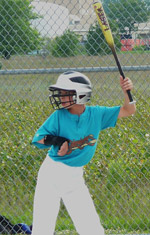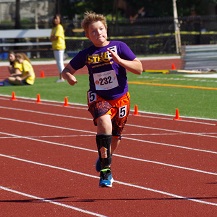Read more about Danny, the young man featured in the video.

Our daughter plays softball
Though no one in our family is a professional athlete, our daughter (age 14, with left hemiplegia and epilepsy) is the 2001 National CP7 Champion in a number of disability track and field events. She also plays “regular” tennis at the tournament level, earning an official USTA ranking of 318 in the state of Florida against able-bodied 14 year old opponents. In addition, her father and I have both been involved in sports and athletics all of our lives as collegiate athletes, children’s coaches, fitness instructors, and recreational/amateur athletes in a number of sports.
In an effort to get into a team sport, my daughter tried a recreational softball league sponsored through our community center for one season. Though she was 11 at the time, I convinced the organizers to let her join in the 9-10 year old team since she was small for her age, had never previously played softball, and because of her disability. Overall, I believe the experience was quite positive. Because my daughter spent years playing tennis, batting was not a problem. Even though she batted with only one hand, it turned out that she was the best hitter on the team. And, because she could hit so well, she was usually able to get on base even though she ran a little slower than many of the other girls due to her AFO (ankle foot orthotic).
The biggest problem my daughter encountered due to her hemiplegia was catching and pitching the ball with the same hand. Though she was slow at first, with practice she improved dramatically. Unfortunately, because she was initially so much slower than the other girls, the coach positioned her in the outfield. As in this age group the ball rarely gets to the outfield, as the kids are too small to hit the ball out that far, she became totally bored. The boredom factor was the key reason she only played only one season of softball and decided to stick with tennis. – Donna
Softball/baseball Hints
 Get your child involved at a very young age, starting with T-ball. This will give your child the opportunity to develop skills and make adaptations when all children of that same age are beginners and all are making mistakes. It will also help your child make friends and become an accepted part of the team while the children are still too young to be concerned about disabilities and differences.
Get your child involved at a very young age, starting with T-ball. This will give your child the opportunity to develop skills and make adaptations when all children of that same age are beginners and all are making mistakes. It will also help your child make friends and become an accepted part of the team while the children are still too young to be concerned about disabilities and differences.
Encourage your child to bat using both hands. This will not only help in arm, hand, and shoulder development; later on it is necessary to protect the chest from being hit by the ball as pitches get faster and wilder in older age groups.
Though there are different methods, my daughter’s method for catching and throwing with the same hand was to catch the ball, then whip glove and ball backhand to the ground with force. As the impact usually caused the ball to pop out of the glove, she would quickly grab the ball and throw it to the infielder. Though she was slow at first, with practice she was usually able to accomplish this maneuver very quickly in a single smooth motion.
Softball/baseball Cautions:
Always have your child wear protective headgear with face/mouth protection.
Softball and baseball become noticeably more hazardous sports at about 11 to 12 years of age when teams convert from soft-pitch done by kids, machine, and/or coach to fast-pitch by kids only. At this point, not only do the pitches get quite wild, many of the kids can be quite big in stature. Thus, the risk of getting hit by a wild, hard pitch goes up significantly at this point. If your child hits with only one hand, requiring a more open stance, the chest is very exposed to a direct hit by a ball, which has the potential to cause serious injury.






